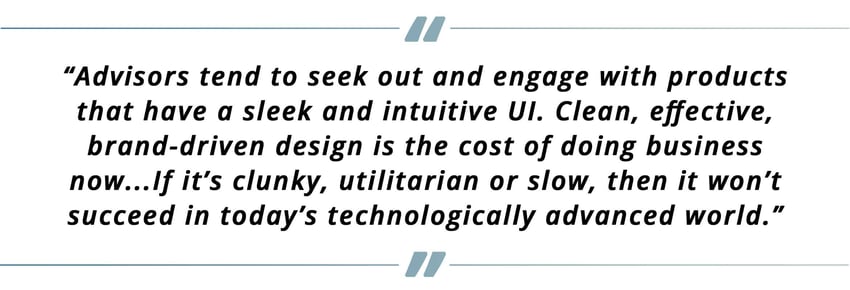Design As An Engine For Growth In FinTech
TAMP & Technology • Written by: Brendan Falls, CFP®

Bringing design front and center
Q&A with Chris Daly, SVP, Chief Digital Officer of GeoWealth
As Chief Digital Officer, Chris oversees all aspects of GeoWealth’s visual and user experience in addition to leading the digital product management team.
Chris’ career has spanned over 20 years, covering UX, product design, strategy and execution. He has led digital product initiatives for global financial brands like JPMorgan Chase, Northern Trust Bank, Bank of America Merrill Lynch and Bloomberg, as well as for leading consumer brands like Sotheby’s, Emirates Airlines and the New York Jets. In this Q&A, Chris shares some of his thoughts on digital and design trends in the fintech space in 2020 and beyond.
What is in store for digital design in 2020 and beyond?
When people talk about digital design, they’re usually referring to Graphical User Interface (GUI). Looking back a few decades, Apple’s 1984 launch of the Macintosh 128K made GUI synonymous with the personal computing revolution through their use of icons and menus. Twenty years later, the same company transformed mobile computing with the GUI-based iPhone. Now over a decade since the first iPhone was introduced, the evolution of user interfaces (UI) as a whole is moving beyond screens and into the physical world with voice, gesture and motion interaction.
Consumers don’t think twice about asking Siri for a gluten-free pancake recipe or telling Apple TV to turn on the third season of The Crown. And when it comes to more sophisticated needs like wealth management, it’s now perfectly reasonable to ask Alexa what the required minimum distribution is for an IRA account. As we enter 2020, we’re already seeing new use cases for these technologies in the wealth management space, with voice-based technology leading the charge. Without a doubt, the industry will need to adopt even more of these B2C trends to further enhance business and service-user needs.

But screen-based UI certainly isn’t going away – it’s actually moving towards bolder and more impactful designs. According to experts, digital designers have .05 seconds to make an impression, so they need to make it count! High-impact design will be a big trend in 2020 with greater use of distinctive and chunky fonts, bright gradients and striking, asymmetrical layouts. We are also seeing the “mobile-first” design trend fade, as the majority of screens used in 2019 were larger resolution or multi-monitor displays. This is especially relevant in fintech, as we know advisors primarily work at their desk with two monitors – not with an iPad on their couch. Put simply, fintech tools need to work how and where advisors work.
What can B2B companies learn from these trends?
Advisors don’t check their expectations at the door when they close down their favorite social media app and fire up their wealth management tools. For both their personal and professional needs, they tend to seek out and engage with products that have a sleek and intuitive UI. Clean, effective, brand-driven design is the cost of doing business now – especially in B2B spaces where “good enough” is simply no longer good enough. If it’s clunky, utilitarian or slow, then it won’t succeed in today’s technologically advanced world. Smart design means higher functionality and a better user experience.
How can design be a differentiator in Advisor Tech?
The advisor technology tools that stand out are those that embrace design as a measure of how things work and not just how they look. Attractive technology doesn’t win business, though aesthetics do play a role. It’s actually the thoughtful application of design principles that are the key differentiators. Why? Because better design yields products that are tailored to solve the specific problems of their users. The tools that win new business deploy methodologies like design thinking to reframe problems in human-centric terms and challenge business-centric assumptions in order to generate innovative, user-first solutions.
Successful firms see clients as more than just a series of CRM touchpoints. They are using service design to craft and curate powerful customer journeys that build loyalty and value from cradle to grave. Over the next couple of years, we will see a continued emphasis on aesthetic intelligence as a desired skill set at every level of a firm. When each department of a fintech firm is entrenched in the psychology of design, the end result will be a stronger product and brand – which means happier advisors.
How is GeoWealth positioned to be design-forward in 2020?
We live a design-centric ethos at GeoWealth, and our products and services are better for it. GeoWealth’s newly updated advisor and client portals have a fresh UI with design thinking at the heart – informed by user feedback, pain-point analysis and industry trends. Sleeker and easier-to-read fonts, streamlined navigation, data-rich dashboards and immersive private labeling are a few of the ways we’re leveraging B2C-style UI to support the needs of advisors looking to take their practice to the next level.
We’re placing an increased emphasis on hiring people with formal design training into every department of the firm – from back-office operations to software development. Furthermore, the full range of our offering is continuing to evolve, from our next generation TAMP to our portal technology, all the way to our back-office capabilities.
For any business, no matter who your end customer is, I recommend you bring design to the center of your product – not because it’s trendy, but because it works. Designing with your end users in mind means you’ll win in 2020 and beyond.

